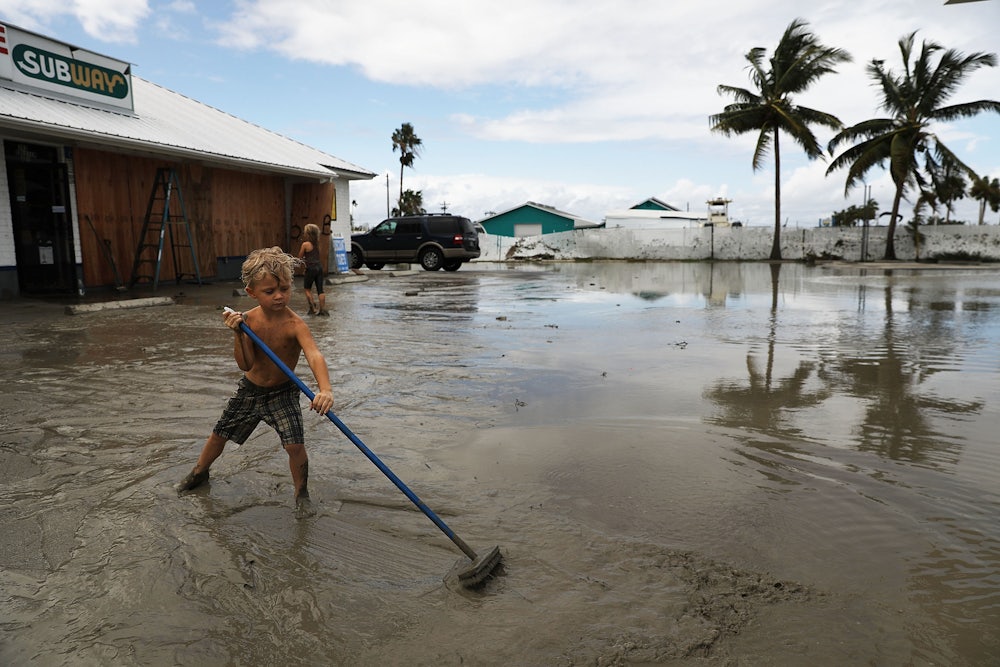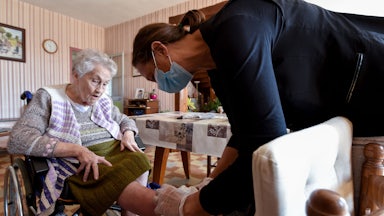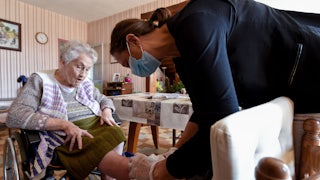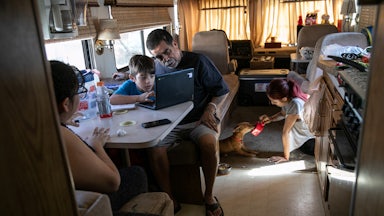When the Intergovernmental Panel on Climate Change released its landmark report declaring “code red for humanity” a few weeks ago, everyone freaked out for about 24 hours. Then, they moved on. The document, despite describing the increasingly dire scenarios ahead if humanity doesn’t change course and decarbonize, garnered less than one-quarter of the social media impressions received by the IPCC’s earlier report in 2018, according to Axios. This flash in the pan came days after the Senate passed an infrastructure bill containing substantially less climate-related funding than the White House and progressive allies had asked for. It is clear the climate crisis—which we are now actively experiencing in heat domes, endless wildfires, and early hurricanes—still badly needs a grounding mechanism, a way to channel the alarmed energy. The climate movement needs children, and children need the climate movement.
The politics of climate change and the politics of care (encompassing caregiving policies for everyone from children to the elderly) are natural allies. Yet while youth climate activists like Greta Thunberg speak of losing their childhood due to the climate crisis, the two issues remain oddly separate when it comes to strategy. Climate chaos threatens not only children’s future, but their present: Young children’s bodies are especially vulnerable to air pollution that is supercharged by heat, and kids experience more severe psychological impacts from disasters like floods and fires. Last week, UNICEF released a groundbreaking Children’s Climate Risk Index, which showed when it comes to exposure to environmental shocks, U.S. children are tied for the third-highest threat level in the world. Moreover, extreme weather catalyzed by global warming can disrupt the physical care infrastructure; after Hurricane Harvey, more than 50 childcare centers permanently closed due to water damage.
On the other hand, the way we care for one another is linked to how we care for the Earth. Slowing global warming requires shifting away from an extractive and consumerist mindset that allows powerful polluters to spew endless carbon because we want the products they create. Yet how can we hope to cultivate a responsible, relational ethic with the planet when we are more than willing to exploit care workers (who are disproportionately women of color) and shrug off the impacts of a free-market system that leaves millions of children in or near poverty and lacking quality care? Less philosophically, the fates of the two issues are now literally connected: The best chance in decades to tackle both care and the climate rests in the Democrats’ $3.5 trillion reconciliation package, which is currently slated to include hundreds of billions for affordable childcare and free pre-K and nearly $200 billion for clean energy development.
There are tremendous political opportunities in forging an alliance. If the climate movement is well funded but diffuse, the care movement suffers from what might be termed political atrophy. Although attention has spiked in the past two years, starting with Senator Elizabeth Warren making childcare a centerpiece of her 2020 presidential campaign, care advocates have for decades gone to battle with more of a war wallet than a war chest. Before Biden, who foregrounded care in his American Families Plan, no president in at least a half-century has made care a major priority. Childcare has no billionaire pouring in nearly limitless funding, no powerful union. One of the only childcare interest groups that lobbies, the Early Care and Education Consortium—which represents for-profit daycare chains like KinderCare and Bright Horizons—spent (in lobbying terms) a paltry $260,000 in 2020. In the same year, the Nature Conservancy alone spent $1.7 million on lobbying, while environmental PACs donate millions each election cycle.
Child-centered policies, however, are widely popular, in contrast to many other policies in this polarized era. A recent poll from Monmouth University found that the American Families Plan—in the face of unified opposition from Republican leadership—not only draws the expected sky-high support from Democrats, but is backed by 58 percent of independents and even a third of self-described conservatives. The most popular provision? Childcare. An earlier survey from the advocacy group First Five Years Fund reported that 63 percent of Republican voters want their member of Congress to work with the Biden administration on early childhood issues. In contrast to the climate crisis, vanishingly few people think the childcare crisis is a hoax.
The care movement brings more to the table than good poll numbers and the moral valence of children, though. While children can’t vote, they don’t come alone. Parents and grandparents constitute a massive if latent political force (over 63 million American parents have a minor living under their roof). Right now only a handful of groups are working to activate parents around climate policy—such as Mothers Out Front and Moms Clean Air Force, to name two.
Coming to climate policy through the door of parenthood, not partisanship, can open new pathways. Part of what blocks parent action is a feeling of being overwhelmed, both in terms of finding the time to advocate and in terms of anxiety that people cannot individually make a difference. Create conditions where parents aren’t cripplingly exhausted and give them tangible policies to fight for, however—stopping fossil fuel projects that pollute the air their children breathe; improving their city’s infrastructure so homes, schools, and daycares don’t flood; electrifying the school bus fleet—and they can move (or, perhaps more aptly, keep in place) mountains. Children’s issues localize the global nature of climate change—and when smoke from California’s wildfires can drive East Coast children indoors and hurt their lungs, localism can also be the entry point for a far wider lens.
So what would it take to forge a true alliance between these previously siloed movements, mobilizing parents for climate policy while putting the muscle of climate warriors behind care? Fighting for the reconciliation bill, which includes spending on both issues, is a good place to start. But in addition to having legislators craft bills that link climate and care, donors must be willing to put in enough money to build out a robust parent- and youth-led movement centered around the twining. Advocates, too, must learn to talk about items like lowering childcare costs and lowering carbon emissions as inextricable parts of a comprehensive solution.
It may even be time to consider conveying new rights to U.S. children in order to safeguard their future. UNICEF is correct to say in its new report that the changing climate is a children’s rights crisis. Yet the U.S. continues to be the sole U.N. member state to not ratify the U.N. Convention on the Rights of the Child. This lack of rights is one reason why children-led climate lawsuits in the U.S. have so far faltered. If our policymakers won’t step up to protect current and future generations, the climate and care movements could rally around legislation or constitutional amendments to force their hand.
We stand at a precipitous moment of peril and opportunity. Too often, climate policy has failed to make it over the legislative finish line; too often, care policy has failed to get on the track. Placing children at the center may provide the missing link that finally moves us toward a healthy society and a healthy planet.








